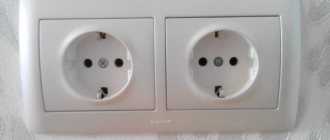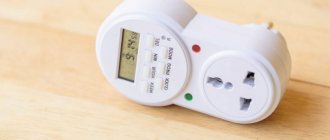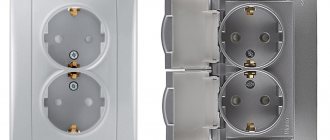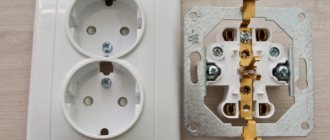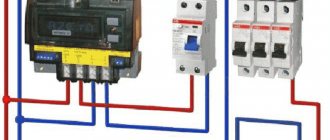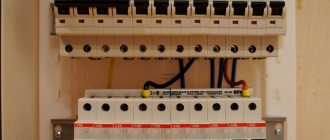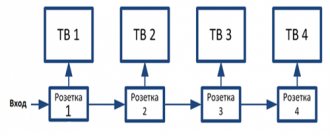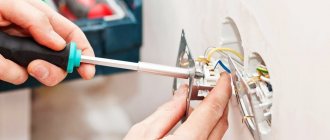Sockets are used to temporarily connect consumers to the electrical network. Their previous types were bipolar. Later, sockets with grounding appeared. At first these were three-phase sockets for 380, then they were followed by the so-called. European socket. Grounded outlets meet new electrical safety standards.
Structurally and in materials, sockets are in many ways similar to switches. The socket device includes a contact socket holder (base), the sockets themselves, their terminals for power wires and a housing. The base has mounting holes or push-down stops for hidden sockets.
What role does grounding play?
When choosing sockets, the main requirements are taken into account - quality and reliability. Grounding outlets in a room ensures the safety of people in the room and long-term operation of electrical equipment connected to this outlet.
We will consider the procedure for connecting a grounded outlet and the features that should be taken into account when choosing and installing it in more detail.
In accordance with the instructions for any electrical device, its use without grounding is prohibited. The main role played by grounding is to ensure stable operation of electrical appliances and prevent the possibility of electric shock.
Based on the rules for constructing electrical installations, grounding is the connection of an element of an electrical installation to grounding. It is created to drain electric current by grounding it into the ground.
Moreover, nowadays, based on photos, you can select sockets with grounding on the websites of manufacturing companies that exactly fit into the design of the apartment.
Distinctive features of a grounded outlet
Externally, a grounded outlet can be easily distinguished by the presence of three metal contacts. Knowing the features of its design, it will not be difficult to connect such an outlet yourself.
Previously, cables with two cores were used in power supply; now the strict requirement is the use of 3-core wiring. Previously, the “neutral” partly played the role of grounding. “Zero” was shorted to the consumer’s body; when an overload occurred, it “took” it.
It was assumed that during an overload, electricity would flow through one of the phases, due to which the electrical network would be closed and turned off by a circuit breaker or fuse. This method posed a risk of electric shock.
Switching on electrical consumers (electric stove, microwave oven) with a metal shell without grounding is strictly prohibited, since a short circuit or damage to the insulating elements of the wiring may cause a breakdown of current to the housing. It is also dangerous to use electrical appliances that interact with water during operation (boiler, washing machine or dishwasher) without grounding.
On sockets from the USA, grounding contacts are in the form of holes with cuts on the sides. French sockets have an additional third pin. In Russia, the most common are German ones - with protruding metal contacts.
According to its design, the electrical outlet with grounding is 3-pin. When an electrical consumer is connected to the network, the ground contacts are closed first, followed by the phase and 0 contacts. Only this switching sequence provides 100% protection.
The plug socket is...
A device that allows you to ensure safe connection of electrical appliances to the network at minimal cost. There is a whole range of plug sockets on the market - waterproof, grounded, dual, but the main principle of operation remains unchanged. The appliance does not function without a plug, so the size and location of the holes must be taken into account. To prevent contact with various objects, a female connector is provided.
Currently, the outdated type of wiring is being replaced, so a plug socket with a grounding contact is becoming an indispensable device. This greatly increases security.
How to choose the right outlet
When choosing an outlet, you need to consider products that have successfully proven themselves. When buying products from unknown manufacturers, you can make a mistake, since their products may not meet the required current value.
According to European standards, there are different classes of protection for sockets. On sale there are sockets with grounding with curtains. These curtains cover the holes for the fork.
There are products with child protection; as soon as an object other than a plug gets into the holes, the protection is activated and the socket is turned off. There are also devices with protection against short circuit, overvoltage, etc.
To power buildings, “internal” sockets are most often used. They are mounted in specialized openings in the walls. When choosing a socket, you usually pay attention to the diameter of the holes for the plug.
European-made models have larger hole diameters. To avoid mistakes, it is better to purchase universal models with a set of connectors for different plugs.
Installation of a grounded outlet
A person who has not previously dealt with 3-wire wiring may wonder: “How to connect a grounded outlet?” First of all, it is worth deciding on the wiring in the installation building. This outlet can only be installed in buildings with 3-wire wiring.
With 2-wire wiring, there is no point in using a grounding outlet, since it will not perform its intended function. Or the 2-wire wiring will need to be replaced with 3-wire.
Next, you should find out whether there is a grounding bus in the electrical panel. This can be obtained from the electrician servicing the house. If there is a bus, it will be enough to replace the 2-core cable with a 3-core one.
The PUE determines that the grounding wire must be copper with a cross-section of 2.5 mm2. With a cable of smaller cross-section, problems will arise with powering high-power devices. In residential buildings, cables marked “VVG” are used; in fire hazardous areas, “VVNng” is more suitable.
Installing a grounded outlet will not create difficulties for anyone who knows the basics of electrical installation work.
Which grounding method to choose
It is possible to correctly connect grounding to sockets in an apartment or house only if there is a grounding bus in the distribution panel. If it is not there, then you can’t do anything on your own - you need to seek connection from the appropriate authorities. All work must be carried out by services servicing the house, and their results are entered into the electrical wiring diagram.
In the private sector, you can make a separate grounding circuit, but it is better to solve this issue during the construction of the house, since in addition to installing the grounding bus itself, you will have to additionally redo the finished wiring.
Installation of the overhead option
According to their design, sockets are of 2 types:
- internal;
- external
Internal sockets are usually chosen when there is hidden electrical wiring.
The overhead version is usually attached to a cable located inside the baseboard box. After completing the preparatory steps and fixing the socket to the wall, you can power the socket.
type of instalation
The open type socket is attached to the wall. These varieties most often have various additional decorative and functional elements.
Plug sockets are installed in most rooms; without them, it is impossible to turn on electrical appliances. The design of the device includes three main elements:
The last detail performs two important functions - protective and decorative. The building can be either single or double. The main part of the device is the block. The cover and contacts are attached to this element. It is usually made of carbolite or ceramics.
Sockets made of carbolite are considered more durable. But a block made of this material is found only in old-style devices. Ceramic products have one significant drawback: they are very fragile, so the device must be installed with great care, since a damaged part cannot be repaired.
Another working element of the socket is the contact, which serves as a conductor of electricity. They are made from metal alloys that have a certain degree of elasticity.
Connecting the internal version
The internal socket is installed in a glass prepared for it, located in the wall. Models installed in plasterboard walls are different from models for concrete or brick walls. The latter are equipped with special spacer elements.
The socket boxes in a concrete wall are fixed by placing alabaster into the finished hole. After installing the socket in the niche, the wiring is carried out.
Installation Rules
In order for the socket to work for a long time, reliably and safely after installation, you need to follow simple rules:
- The electric point should be installed at a height of 30 to 80 cm from the floor level, with the exception of above-plinth models.
- Models equipped with a grounding contact should be installed no closer than 50 cm from appliances or a gas pipe.
- If there are children in the house, sockets should be installed higher.
- Single or double plug sockets for hidden installation should be encased in an iron or plastic case, and the wire reserve in them should be 5-6 cm.
- When laying a new power supply line, you should immediately take care of installing power points.
- If you need to place several sockets in a row at once, you can use boxes designed to install two sockets at once. When installing a larger number, you should prepare a group of socket boxes that are secured to each other.
- You can use a “loop” connection scheme, when the contacts of the previous outlet are combined with the power of the next one, or you can use the option of connecting to a separate line.
Before proceeding with the installation of the plug socket, it is imperative to turn off the power supply and also use the indicator to check the voltage.
Connecting wires
Before carrying out installation work, the room must be de-energized. The prepared cables are inserted into the socket box. Using the tester, “phase” and “0” are determined. If you do not have a tester, you can use an indicator screwdriver.
In the complete absence of the above tools, the identity of the wires can be determined by generally accepted markings. Each core has its own insulation color: - the neutral wire is blue or light blue;
- phase – bright colors;
- grounding is yellow-green.
With non-traditional marking, finding the “phase” is much more difficult.
The prepared wires are stripped of insulation 10–15 mm from the edge. Carrying out the work requires care, as damage to the core will lead to a short circuit.
It is also worth paying attention to the reliability of the connection of the wires to the terminals - poor contact can cause an increase in current and heating of the cables.
Checking the correct connection
A check is carried out to ensure that the socket is connected correctly. It is not difficult to carry out using a multimeter or an indicator screwdriver.
When you touch the “phase” the screwdriver should light up. If the screwdriver reacts to touching the ground, then the socket is connected incorrectly.
Double socket
There is often a shortage of free sockets when several consumers are using them simultaneously. To partially solve the problem, there are double sockets with grounding.
By design, this type of sockets, like regular ones, has a body and a working part with contacts. Double sockets are internal and external and have the same installation and power supply principles as single ones.
Grounding outlets can significantly increase the level of safety of the electrical network and minimize the possibility of an accident.
Types and sizes
Depending on the type of installation, there are internal and external sockets. Internal ones are installed together with contacts and a box in the wall, which is convenient for users. Installed only on hidden wiring. External (overhead) ones are used for external wiring and are mounted on top of the wall. The installation process is simple, but such devices can be inconvenient in everyday life.
Based on the number of poles, single-pole, double-pole, three-pole and four-pole sockets are distinguished. In Russia, two-pole devices are predominantly used.
Domestic
Installation of an internal type socket is complicated. Installed directly into the wall. The body is a metal or plastic socket box fixed to the wall with plaster or cement glue. The block is installed on the socket box and tightened with screws.
Recessed type
For installation, a special niche is made in the wall where the mounting box is attached. The disadvantage is that the device must be tightened periodically, as the connection may come off a little. For reliable fastening, use a screw fastening directly to the box. When installing, firmly attach the ends of the wires to the contacts, since this is where burnout or sparking most often occurs.
External
External (or overhead) sockets are used when installed in cables or pipes. This type is used when it is impossible to install hidden wiring or in industrial premises where constant access is required. Internally, external and recessed type sockets are practically the same, the only difference is in the type of installation. External sockets can be additionally equipped with an electronic timer, lighting, push-button plug ejector and other necessary functions.
With ground contact
Modern homes have new requirements for electrical wiring. It is mandatory to have grounding circuits. Since some household appliances are metal electrical installations with high power. Unlike traditional devices, grounding sockets have 3 (for a single-phase network) or 5 (for a three-phase network) contacts. Otherwise the design is no different.
With safety contact
Also used for new types of wiring. In plug sockets, the protective contact is connected to the ground wire. The design of the device has special sockets for receiving the protective contact bracket.
